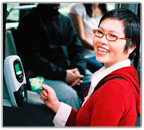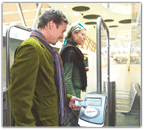Northern California’s TransLink transit card uses dual interface technology
02 July, 2004
category: Contactless, Library, Transit
Someday, in the not-too-distant future, a rider could use one smart card to travel across some 26 mass transit systems in northern California. The system, TransLink, billed as the first dual interface system (utilizing both contact and contactless interfaces to the same chip) in the U.S., is in the testing phases now. When fully implemented over the next couple of years, 700,000 riders will use a single TransLink smart card instead of paying fares with cash, passes, or tickets.
One of the agencies involved in the phase one testing completed late last year was the Bay Area Rapid Transit District, also known as BART. BART is a heavy rail system that operates 600 cars traveling more than 100 miles of track in the San Francisco area. It’s history dates back to 1957 when the California Legislature formed the San Francisco Bay Area Rapid Transit District. But it took 15 years before BART’s rail system was officially open for business. The $1.6 billion enterprise includes the 3.6-mile Transbay Tube that runs beneath the San Francisco Bay at depths of up to 135 feet. The tube alone cost $176 million.
BART is just one of 26 transit agencies operating in northern California. Overseeing all of these agencies is the Metropolitan Transportation Commission (MTC), said BART’s Thomas Parker, department manager for fare collection. MTC is also the program sponsor for TransLink.
Mr. Parker, who has been with BART for 10 years, is also chairman of the Universal Transit Farecard Standards Task Force, or UTFS for short, which is funded by the U.S. Department of Transportation and some American Public Transportation Association (APTA) members. UTFS is seeking a uniform, open source transit fare standard so one smart card would be useable with any mass transit agency ascribing to the standards UTFS will eventually develop (See Contactless News, May 2004).
Phase one of the TranskLink program took two years to complete and involved a pilot test in which 10,000 users got to try out the system. Phase two of TransLink involves “rolling out the smart card system,” said Mr. Parker.
The card certainly seems to have the backing of San Francisco’s transit riders. Russell Driver, Booz, Allen Hamilton, program consultant for MTC, said that more than three-quarters of Bay Area voters “ranked a universal fare card as their No. 1 transportation priority.”
But less than half of the 10,000 cards issued in the pilot were used in the system, added Mr. Driver. He told an industry group early this year that the pilot program confirmed that the technology works for different modes, agencies, and fare types, that the back-end operation functioned properly, and that nine out of ten cardholders were satisfied with the system.
“The test,” said Mr. Parker, “gave us the opportunity to see that the card worked and allowed us to work out the bugs. Proving out the backend system was very critical,” he added. “We were able to see what issues, if any, we had with software and hardware.”
Contractor for the $150 million project is ERG Transit Systems (USA) Inc, a member of the Australian-based ERG Group that specializes in smart card-based fare collection and management systems. Six major transit agencies in the San Francisco Bay Area have agreed to participate in a full-scale implementation of the TransLink smart card fare collection project. These agencies, besides BART, include San Francisco MUNI (Municipal Railway), AC Transit, Golden Gate Bridge Highway and Transportation District, Santa Clara Valley Transit Authority, and Caltrain. Cubic Transportation Systems is providing the readers, at least for BART.
ERG calls TransLink one of the largest regional smart card-based transit fare collection systems being developed in the U.S. It eventually is expected to handle more than 25 million smart card transactions every month. ERG will process all transactions and settle payments among operators daily.
“Regional fare collection and settlement is now becoming a reality for the San Francisco Bay Area,” said Mike Nash, general manager of ERG’s American operations. “The tremendous value and benefits of region-wide smart card based fare collection have been proven around the world in systems developed by ERG.”
“The card is not actually in service now (for BART),” said Mr. Parker, “but once it’s operational, (probably in 2005-2006) you’ll be able to purchase a card from a number of different entities. The stored-value card will allow you to ride different transportation modes within the region, such as trains, ferries, trolleys, commuter rail, heavy rail and light rail.”
The card will eventually be useable as well in some 25,000 parking meters in the bay area, said Mr. Driver. This application will utilize the card’s contact interface rather than the contactless interface used for fare collection.
Even when the TransLink card is operational throughout the system, “we’re going to continue to use our standard mag stripe tickets,” said Mr. Parker. “A few of the (transit) agencies may consider using only the smart card, but we’re pretty solid on mag stripe.”
He said the smart card “has a lot of advantages, operationally, but it draws on the bottom line because we have to incorporate this cost in our operational budget. We believe over the long run the return, once we can get rid of the plastic tickets, will be significant.”
The phase-out of those plastic tickets will happen one day, “but in order to do that,” said Mr. Parker, “we’ll need a phased approach. People overnight are not going to change their ticket habits.”
Another issue is that of temporary riders, the tourists and other occasional riders who would have no use for a smart card once they leave the MTC area. One possibility, said Mr. Parker, is to require a deposit on a smart card that the rider can recoup once he turns the card back in.
BART is already preparing for the TransLink system. It recently completed installation of its new ticket vending machines (TVMs) at all of BART’s 43 stations. This state-of-the-art ticket vending equipment is one of the major components of BART’s $1.2 billion renovation program that includes 572 fare gates, 162 adfare machines, and 299 TVMs.
The TVMs now include the ability for riders to purchase multiple tickets with one transaction, purchase tickets of up to $60 in value, and use credit or debit cards, as well as cash. The devices will issue the more durable plastic tickets that have replaced BART’s original paper tickets and will also issue the TransLink cards in the future. Additionally, the new TVMs are also capable of reloading value on the Translink tickets once they are in circulation.
The size and extensive reach of the TransLink project as well as the selection of the dual interface smart card technology makes the project one worth watching. Stay tuned to Contacless News for updates in the future.



